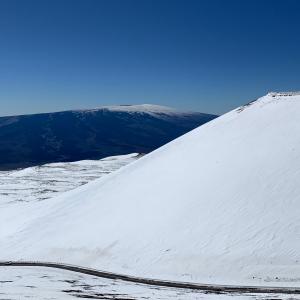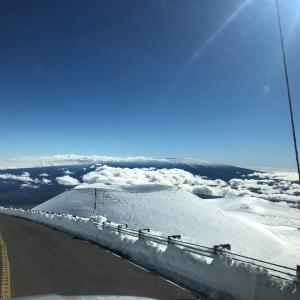Road to Maunakea summit reopened, Rangers remind public of dangers
University of Hawaiʻi at HiloThe University of Hawaiʻi at Hilo Center for Maunakea Stewardship (CMS) has fully reopened the road to the summit after crews cleared it of thick ice and heavy snow following the recent storm. However, Maunakea Rangers warn that conditions on the mauna can change quickly and become dangerous.
Icy build up coating Maunakea Access Road along with snow drifts made it exceptionally difficult for CMS staff to remove. This made clearing the roadway much slower than usual.
Rangers are anticipating an increase in summit traffic, which is typical after a heavy snowfall and urge the public to exercise caution at all times.
The public is asked to remember that the summit of Maunakea can be one of the most dangerous places in Hawaiʻi because of the extreme altitude and rapidly changing weather conditions. The Rangers are reminding visitors that small children do not do well at high altitudes and pets are not allowed up to the summit.
“We understand lots of kamaʻāina and visitors are looking forward to driving up to the mauna. However, we urge everyone to please adhere to all directions and precautions from our Maunakea Rangers,” said Nahua Guilloz, director of stewardship at CMS. “Safety is of utmost importance to us and we need the public’s kōkua to help keep everyone free from harm.”
Emergency services may be two hours away because of the mountain’s remote location. Cell phone coverage is unreliable, and there is one public emergency phone on the summit.
Maunakea Summit Road and summit area
The summit access road is approximately eight miles long, and the first five miles are unpaved with steep inclines, poor traction, narrow sections where two way traffic is not possible, blind curves and rocks on the road. Drivers are asked to remember the following:
- Only 4-wheel drive vehicles are allowed beyond the Visitor Station.
- Vehicles should be in good working condition, especially the brakes, contain sufficient fuel and be free of invasive species, which can be an issue with dirty and muddy vehicles.
- Adhere to the 25 mile-per-hour speed limit and be aware of other vehicles and pedestrians on the road.
- While going down the mountain, use a low gear to prevent brake failure and do not ride your brakes.
- If you experience brake loss, turn into the mountainside to avoid rolling down.
- Road conditions become more hazardous when there are deep snow drifts.
- Before leaving, check the weather and summit road conditions online at Maunakea Weather Center.
- Do not litter or disturb terrain or rock piles.
- Use the portable toilets at the Visitor Station and on the summit. Do not go to the bathroom outdoors.
- Pets are not allowed on UH-managed lands on Maunakea, including the summit, Maunakea Summit Road and the Visitor Station.
Snow, sun and weather
Snow on the summit will typically have a thick layer of ice on top that makes it very hard to steer or stop. The slopes are very steep with rocky outcroppings at the bottom, which is where most serious injuries occur. It is strongly advised NOT TO USE inner tubes, boogie boards or other devices that are NOT equipped with braking or steering mechanisms.
Wear sunscreen and sunglasses because of the high risk of sunburn and eye damage, as the summit is above much of the atmosphere that blocks the sun’s damaging ultraviolet rays. The threat increases if there is snow on the ground.
The weather can change rapidly, resulting in severe conditions including freezing temperatures, snow storms and high winds. Dress and prepare appropriately.
Exposure to altitude
The summit elevation is 13,796 feet (4,205m), and there is 40% less oxygen available there compared to sea level. With the greatly reduced oxygen level, visitors can experience altitude sickness that could include shortness of breath, impaired judgment, vomiting and a loss of consciousness. In extreme cases it could lead to life-threatening conditions.
All travelers to the summit are asked to acclimate to the high elevation by spending at least a half hour at the Visitor Information Station located at the 9,200 ft (2,804 m) elevation, which can lessen the intensity or onset of altitude sickness.
Visitors should:
- Keep hydrated to help you avoid elevation sickness and NOT drink alcoholic beverages before or while on the Maunakea summit road.
- Do not travel above the Visitor Information Station if you:
– Are pregnant
– Are in poor physical condition, especially if you have heart and respiratory problems
– Are a child under the age of 13
– Have gone scuba diving within 24 hours - When on the summit, move slowly and deliberately and always remember you are already physiologically impaired due to the reduced atmosphere.
Be safe and respectful
Everyone is encouraged to act in a safe and responsible manner while on Maunakea and look out and care for others because of the dangerous conditions. Please be respectful of the fact that Maunakea is one the most revered places in Hawaiʻi, and many visit the mauna for cultural and religious practices.
More health and safety information can be found online.



